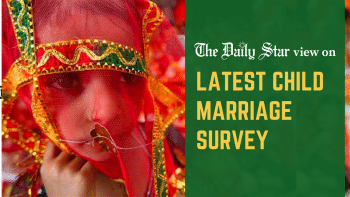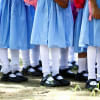An alarming upswing in child marriage

At least 41.6 percent of young women in Bangladesh were married before they had turned 18, reveals the latest government survey.
The survey -- Bangladesh Sample Vital Statistics-2023 (BSVS-2023) conducted by the Bangladesh Bureau of Statistics (BBS) and released on Sunday -- also shows a rising trend of child marriages over the previous three years.
In the survey conducted in 2022, at least 40.9 percent of women were found to have been married before turning 18, in 2021 the number was 32.4 percent, and in 2020, it was 31.3 percent.
BSVS-2023 also found that 8.2 percent of young women had gotten married before they were 15. The number was 6.5 percent the year before.
The survey was on over 3.08 lakh households across the country and on married women who are now between 20 and 24.
It found that child marriage is more prevalent in rural areas with 44.4 percent of women getting married before the age of 18.
Under the Child Marriage Restraint Act 2017, the legal age for marriage is 18 for women.
The BBS survey, however, differs significantly from the data of the Bangladesh Demographic and Health Survey (DBHS) 2022 conducted by the National Institute of Population Research and Training (NIPORT).
The NIPORT survey found that 51 percent of girls are married before they turned 18.
According to a Unicef report released in May last year, the prevalence of child marriage in Bangladesh is the highest in South Asia and the eighth highest in the world.
Child marriage perpetuates a cycle of poverty by cutting short the girls' education, pushing them into early and repeated pregnancies, and limiting their employment opportunities.
Although the Bangladesh Sample Vital Statistics-2023 did not analyse the reasons behind the rise in child marriage, experts blamed poverty, safety concerns, and customs.
Shaheen Anam, executive director of the Manusher Jonno Foundation, said, "The main drivers include social norms, in which marrying off daughters is perceived as a solution due to concerns about elopement; safety concerns, stemming from the belief that marrying off daughters at a young age provides security and safeguards their well-being in uncertain circumstances; and poverty, which is particularly prevalent in climate change-affected and remote areas where families see it as one less mouth to feed.
She also blamed the lack of proper enforcement of the law and mostly dysfunctional committees and authorities, who have been mentioned in the action plan to prevent child marriage.
The Child Marriage Restraint Act 2017 mandates establishment of child marriage prevention committees at national, district, upazila, and union levels, consisting of government officials, local representatives, non-government officials, and community leaders.
Shaheen Anam said although some upazila nirbahi officers are proactive in trying to stop child marriages, the work is limited on raising awareness among parents about the negative effects of child marriage and advocating girls' education.
The increasing trend of child marriage also results in a very high rate of adolescent pregnancies.
As per BSVS-2023, the rate of girls, aged between 15 and 19, giving birth to children is 73.
The number was 70 according to the survey conducted in the previous year .
This indicates that more children are being married off and they are becoming pregnant in their teens. Teen pregnancies compromise their health and wellbeing.
The BSVS-2023 found that more than 25 percent of all pregnant women were aged between 15 and 19.
About increasing teen pregnancies, Shaheen Anam said, "Girls married in their teens have no decision-making power in the family and they cannot even access contraception. How can she decide the time and number of pregnancies?"
On teen pregnancies in rural areas, Raunak Jahan, an assistant professor at the Shaheed Suhrawardy Medical College and Hospital's Gynecology & Obstetrics department, said, "We often see girls under 16 coming to us with their second pregnancy, which means they gave birth to their first baby by the age of 15.
"When we ask why they became pregnant, many say that having a baby secures their marriage or strengthens their position with their in-laws," she noted.
But this is very risky because adolescent mothers' bodies are still developing, and their organs are not fully matured, she said.
Raunak emphasised the need to change societal perceptions towards girls and to take appropriate action to address the challenges of child marriage and teenage pregnancies, particularly in rural areas.
Shaheen Anam said, "The Child Marriage Restraint Act needs to be properly enforced and the committees should be functional."
Emphasising awareness, she said, "We need to change our social perception towards girls. Instead of marrying them off at an early age, we should advocate girls' education and make parents understand the benefits of educating a girl."

 For all latest news, follow The Daily Star's Google News channel.
For all latest news, follow The Daily Star's Google News channel. 









Comments